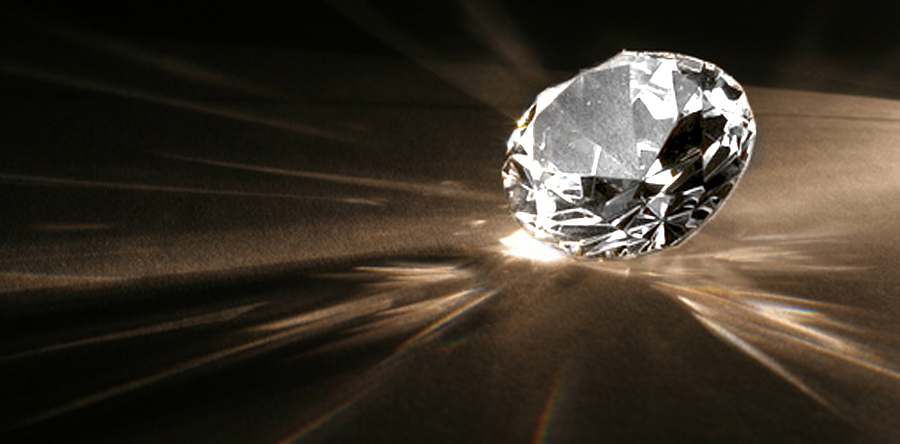It can be argued, successfully, that the most important of all the four C’s of diamonds (cut, color, clarity, and carat) is the cut. The cut is often confused with the shape. Jewelers will know what a customer means when they say “princess cut” or “pear cut,” but those truly are simply referring to the shape of the diamond. The cut of a diamond refers to something much more: the way light interacts with the diamond.
When light enters a diamond, it is reflected in very specific patterns around the internal and external facets. The light then exits the diamond through the top. This light reflection produces the glittering shine we see from diamonds.
Most people associate the diamond’s cut success by the “sparkle” it has. This is only partially true. There are actually three different categories used to describe the light reflection and refraction quality.
The brightness of the diamond refers to the white light reflected by the diamond, both inside and outside. The fire of the diamond, in contrast, refers to the way the white light scatters into the colors of the rainbow inside the stone. Lastly, the scintillation is the amount of sparkle a diamond has. The scintillation is the pattern of dark and light spots inside the diamond.
Light reflection in a diamond should follow a very careful pattern, so as to maximize the light. To promote perfect refraction, the proportions of the diamond, the symmetry of the facets, and the polish of the stone are made in specific ways.
There are five major components of a cut diamond. All cut diamonds, regardless of shape, will have these five parts. For illustration purposes, consider the round diamond, as it is the most popular choice of diamond shape for engagement rings and wedding bands. The flat top of the diamond is the largest facet on the stone and is called the table. The angled top part of the diamond, from the table to the widest point of the diamond, is called the crown. The widest part of the diamond is called the girdle. The girdle, from a distance, may look like a sharp point, but it is actually blunted and faceted. The largest part of the diamond is the upside down pyramid shape below the girdle. This is called the pavilion. The bottom most point of the diamond is called the culet.
These parts have specific sizes in relation to each other. The width of the diamond, looking at the girdle, is the basis for these size relationships. The table should be between 53% and 57% of the width of the diamond. The length of the crown from table edge to girdle should be 15.1% to 16.5% of the width. The girdle should come in at 1% to 2.5%, and the pavilion, from girdle to culet, should be 42.9% to 43.3% of the total width of the diamond. Furthermore, the angle at which the crown extends up from the girdle should be 34 degrees, and the pavilion’s angle down from the girdle should be 41 degrees.
Depending on the cut’s precision and execution, the diamond cut is given a grade. The Gemological Institute of America uses a 5-level grading system. The very best grade a diamond’s cut can be given is “excellent.” From there, the stones go to “very good,” “good,” “fair,” and lastly “poor.” Of all the qualities a diamond is graded on, the cut is the most technically difficult and complex to evaluate. It requires great skill and knowledge.
Excellent stones will have even patterns of light and dark areas, no matter what shape the diamonds are cut in. This is harder to achieve with certain shapes. Stones which are longer than they are wide, but are fully faceted (like ovals and marquis), are sometimes plagued with a dark band across the middle, which is caused by uneven scintillation and negatively affects the diamond’s cut grade.
Very good diamonds will have some very minor cut imperfections. The crown may be too tall, resulting in scintillation that looks a little bit like splintered glass, instead of larger oblong facets. To the naked eye, this stone wouldn’t look significantly different than the very best cut diamonds.
Good diamonds have more cut imperfections, but are still very pretty. A good stone might have a crown that is too shallow, making the center of the stone look a little darker than it should. This is caused by not enough light getting reflected straight out of the top of the diamond.
Fair cut stones might have a pavilion and a crown that are cut too steeply. This will leave darker edges around the girdle of the stone and a general darkening of the stone, as too much light is reflected out of the bottom of the stone, instead of bouncing back out the top.
Diamonds with a poor grade in their cut will not have the fire, brightness, or scintillation one expects from a diamond. These stones will often have an almost glassy appearance, and the scintillation pattern will look too large, instead of the small even patterns that should be seen. The light will reflect very poorly in these stones.





